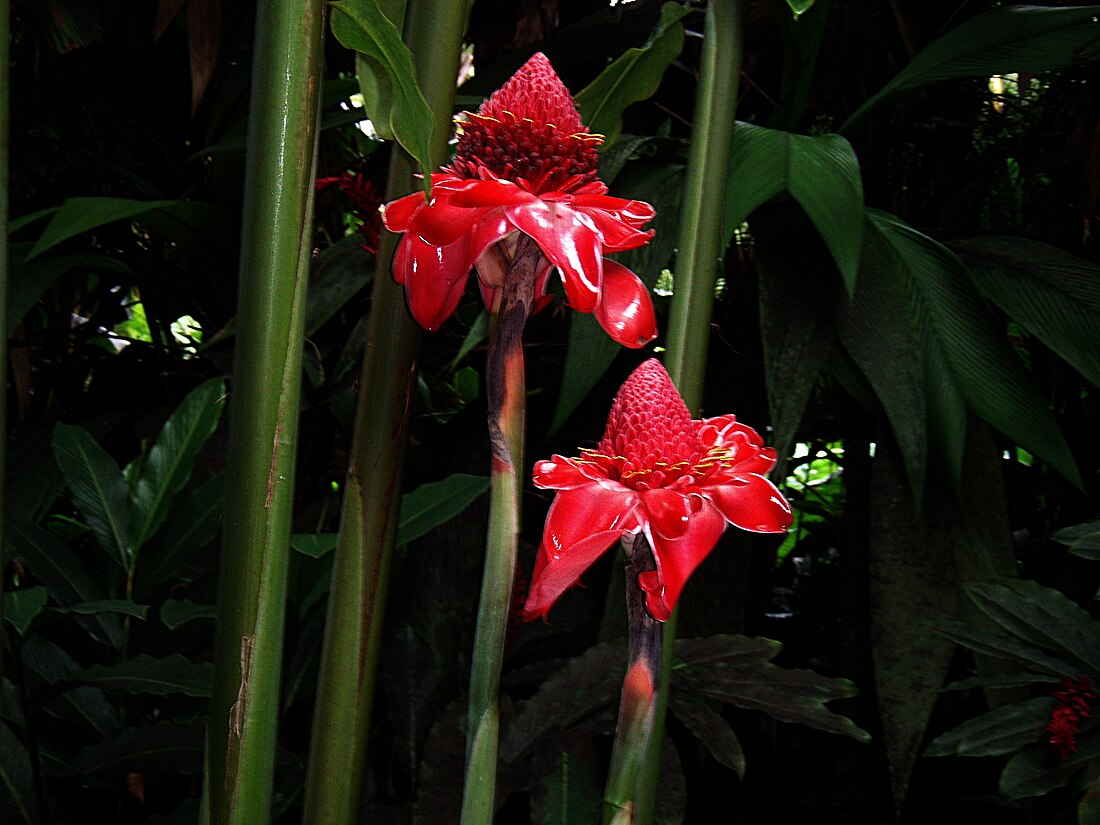Zingiberaceae
Family of plants From Wikipedia, the free encyclopedia
Zingiberaceae (/ˌzɪndʒɪbɪˈreɪsi.iː/) or the ginger family is a family of flowering plants made up of about 50 genera with a total of about 1600 known species[4] of aromatic perennial herbs with creeping horizontal or tuberous rhizomes distributed throughout tropical Africa, Asia, and the Americas. Many of the family's species are important ornamental, spice, or medicinal plants. Ornamental genera include the shell gingers (Alpinia), Siam or summer tulip (Curcuma alismatifolia), Globba, ginger lily (Hedychium), Kaempferia, torch-ginger Etlingera elatior, Renealmia, and ginger (Zingiber). Spices include ginger (Zingiber), galangal or Thai ginger (Alpinia galanga and others), melegueta pepper (Aframomum melegueta), myoga (Zingiber mioga), korarima (Aframomum corrorima), turmeric (Curcuma), and cardamom (Amomum, Elettaria).[5]
| Ginger family Temporal range: | |
|---|---|
 | |
| Red torch ginger (Etlingera elatior) | |
| Scientific classification | |
| Kingdom: | Plantae |
| Clade: | Tracheophytes |
| Clade: | Angiosperms |
| Clade: | Monocots |
| Clade: | Commelinids |
| Order: | Zingiberales |
| Family: | Zingiberaceae Martinov[2] |
| Type genus | |
| Zingiber Boehm. | |
| Genera[3] | |
|
57; see text | |
Evolution
The earliest known fossils of the family belong to the Campanian age and are from the genera Spirematospermum in Germany,Tricostatocarpon and Striatornata in Mexico, and Momordiocarpon in India.[6][7] Spirematospermum chandlerae from the Santonian of North Carolina was previously classified in the Zingiberaceae, but more recent studies support it belonging to the Musaceae.[8][1]
Description
Members of the family are small to large herbaceous plants with distichous leaves with basal sheaths that overlap to form a pseudostem. The plants are either self-supporting or epiphytic. Flowers are hermaphroditic, usually strongly zygomorphic, in determinate cymose inflorescences, and subtended by conspicuous, spirally arranged bracts. The perianth is composed of two whorls, a fused tubular calyx, and a tubular corolla with one lobe larger than the other two. Flowers typically have two of their stamenoids (sterile stamens) fused to form a petaloid lip, and have only one fertile stamen. The ovary is inferior and topped by two nectaries, the stigma is funnel-shaped.[citation needed]
Some genera yield essential oils used in the perfume industry (Alpinia, Hedychium).
Genera
Summarize
Perspective
57 genera are accepted.[3]
- Adelmeria Ridl.
- Aframomum K.Schum.
- Alpinia Roxb.
- Amomum Roxb.
- Aulotandra Gagnep.
- Boesenbergia Kuntze
- Burbidgea Hook.f.
- Camptandra Ridl.
- Caulokaempferia K.Larsen
- Cautleya (Royle ex Benth.) Hook.f.
- Conamomum Ridl.
- Cornukaempferia Mood & K.Larsen
- Curcuma L.
- Cyphostigma Benth.
- Distichochlamys M.F.Newman
- Elettaria Maton
- Epiamomum A.D.Poulsen & Škorničk.
- Etlingera Giseke
- Gagnepainia K.Schum.
- Geocharis (K.Schum.) Ridl.
- Geostachys (Baker) Ridl.
- Globba L.
- Haniffia Holttum
- Hedychium J.Koenig
- Hemiorchis Kurz
- Hornstedtia Retz.
- Johoralia C.K.Lim
- Kaempferia L.
- Kedhalia C.K.Lim
- Lanxangia M.F.Newman & Škorničk.
- Larsenianthus W.J.Kress & Mood
- Leptosolena C.Presl
- Meistera Giseke
- Myxochlamys A.Takano & Nagam.
- Nanochilus K.Schum.
- Newmania N.S.Lý & Škorničk.
- Parakaempferia A.S.Rao & D.M.Verma
- Perakalia C.K.Lim
- Plagiostachys Ridl.
- Pleuranthodium (K.Schum.) R.M.Sm.
- Pommereschea Wittm.
- Pyrgophyllum (Gagnep.) T.L.Wu & Z.Y.Chen
- Renealmia L.f.
- Rhynchanthus Hook.f.
- Reidelia Oliv.
- Roscoea Sm.
- Scaphochlamys Baker
- Siamanthus K.Larsen & J.Mood
- Siliquamomum Baill.
- Siphonochilus J.M.Wood & Franks
- Stadiochilus R.M.Sm.
- Sulettaria A.D.Poulsen & Mathisen
- Sundamomum A.D.Poulsen & M.F.Newman
- Tamijia S.Sakai & Nagam.
- Vanoverberghia Merr.
- Wurfbainia Giseke
- Zingiber Mill.
Taxonomy
Summarize
Perspective
| Cladogram: Phylogeny of Zingiberales[9] | ||||||||||||||||||||||||||||||||||||
|
Phylogenetic tree of the family
Subdivisions




- Subfamily Siphonochiloideae
- Tribe Siphonochileae
- Subfamily Tamijioideae
- Subfamily Alpinioideae
- Tribe Alpinieae
- Adelmeria
- Aframomum - grains of paradise
- Alpinia - galangal
- Amomum
- Aulotandra
- Cyphostigma
- Elettaria - cardamom
- Elettariopsis
- Etlingera
- Geocharis
- Geostachys
- Hornstedtia
- Lanxangia
- Leptosolena
- Plagiostachys
- Renealmia
- Siliquamomum
- Vanoverberghia
- ×Alpingera F. Luc-Cayol (Alpinia × Etlingera) - intergeneric hybrid
- Tribe Riedelieae
- Tribe Alpinieae
- Subfamily Zingiberoideae
- Tribe Zingibereae
- Boesenbergia
- Camptandra
- Caulokaempferia
- Cautleya
- Cornukaempferia
- Curcuma - turmeric
- Curcumorpha
- Distichochlamys
- Haniffia
- Haplochorema
- Hedychium
- Hitchenia
- Kaempferia
- Kedhalia
- Laosanthus
- Myxochlamys
- Nanochilus
- Newmania
- Parakaempferia
- Pommereschea
- Pyrgophyllum
- Rhynchanthus
- Roscoea
- Scaphochlamys
- Smithatris
- Stadiochilus
- Stahlianthus
- Zingiber - ginger
- Tribe Globbeae
- Tribe Zingibereae
- subfamily unknown
Distribution
The Zingiberaceae have a pantropical distribution in the tropics of Africa, Asia, and the Americas, with their greatest diversity in South Asia.
References
Bibliography
External links
Wikiwand - on
Seamless Wikipedia browsing. On steroids.
